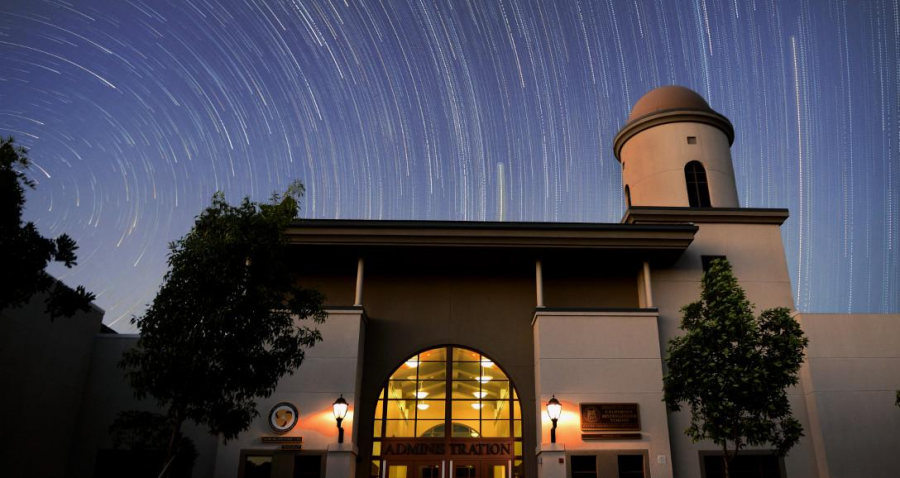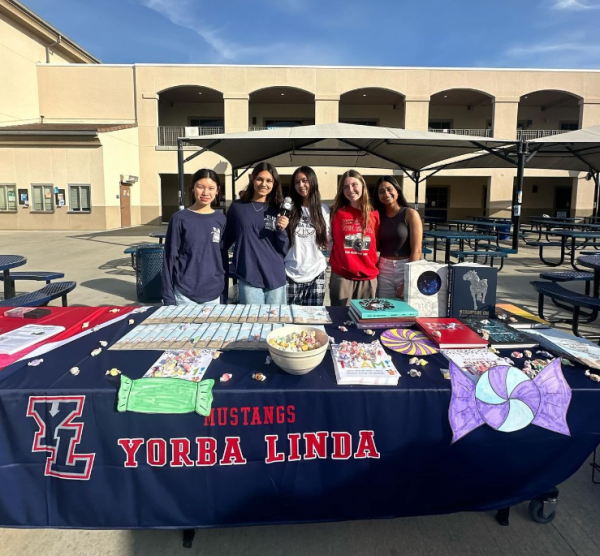Stargazing in Yorba Linda
The path of stars traveling across the sky in a single photo over Yorba Linda High School.
December 2, 2020
History tells us of the ancient use of stars for navigation, from ships roaming the Mediterranean to trading caravans cresting the sand dunes in the Middle East. The firmament had, in the past, been speckled with glistening stars at night, giving rise to myths and legends that still remain famous and noted today, particularly the Zodiac constellations and Greek myths. However, due to accumulated volumes of light pollution –excessive artificial light– much of the brilliant starlight that we hear of in classic literature is invisible in suburban Yorba Linda. Regardless, the winter season has brought along with it a new showcase of stars and constellations for us to enjoy despite our modern shortage of starlight.
The most prominent and easiest to view in the suburban area of the new winter arrivals are the constellations of Orion, Taurus, Auriga, Canis Major, Canis Minor, and Gemini. Due to the rotation of the Earth, the stars rotate every season, meaning that our winter constellations will be fading away in the spring and completely below the horizon in the summer, before making another return in the winter. On the other hand, constellations that remain visible throughout the year are called circumpolar constellations as they appear to rotate around the North Pole. Circumpolar constellations visible in suburban light pollution include Cassiopeia, Cepheus, Ursa Major, and Ursa Minor. The constellation Ursa Minor contains Polaris, popularly nicknamed ‘the North Star’ because it always points travelers north. This is because Polaris as a star is positioned almost directly above the North Pole — following nonstop in the direction of the star will most certainly land you a very short distance away from the Pole at the end of your trip.
Each prominent constellation is linked to a unique myth or legend from ancient civilizations. The constellation of Orion is notably linked to the Greek myth of the hunter Orion, whose belt and sword are reflected in the bright three stars lined up diagonally in the middle of the hourglass shape. Ancient Arab astronomy has also left its mark on the stars as well, as seen in Arabic star names such as ‘Rigel’ in the constellation Orion and ‘Altair’ in the summer constellation Aquila.
The twelve Zodiac constellations include Aries, Taurus, Gemini, Sagittarius, Virgo, Pisces, Aquarius, Cancer, Leo, Libra, Capricornus, and Scorpius. These are unique in that, from the Earth, the Sun appears to pass through these constellations throughout the year. Using the Zodiac constellations, ancient cultures would scrutinize and follow this cycle to determine the time of the year. Today, Zodiac constellations are immensely popular in astrology, which derives a person’s traits and characteristics from a corresponding Zodiac constellation.
To remedy the issues of light pollution, technology has also developed to aid us with visuals in stargazing and sky cartography. The free digital planetarium application, Stellarium, offers a visual of the night sky with details about its stars and constellations with the option to remove visual shielding from the atmosphere.
However, nothing beats the live experience of seeing the heavens’ speckled blanket and its ancient patterns with our own eyes. Amber Han (11) gives her thoughts on Yorba Linda’s situation with light pollution. “Personally, I think people at home won’t do much to reduce their light usage,” she says. “But large lights for big places like fields and stadiums should be turned off when not in use during the evening and night.”
Despite the faded starlight and expansive dark gaps in the night sky, winter’s bright gifts are still something that should be enjoyed, even if somewhat dulled by nearby streetlights. Tonight, head outside on your doorstep or balcony to take in the starry patterns and marvel at their long-lasting stories — just like our ancestors did thousands of years ago.






















Fiona Salisbury • Dec 10, 2020 at 2:52 PM
This article made me wish that we were able to view stars better from Yorba Linda, but I will definitely be looking for more chances to view stars.
Blake Kingsbury • Dec 10, 2020 at 11:43 AM
This article really helps with understanding what stargazing is all about. I hope to do it myself very soon.
Eunice Ahn • Dec 10, 2020 at 8:35 AM
I wish we are able to see stars at night. I feel like it’ll be such an amazing sight and somewhat magical sight as well. It’s kind of sad how not being able to see the stars is normal for many of us.
Emma Perron • Dec 10, 2020 at 7:39 AM
This article is amazing and well written. I love going out at night and looking at the stars and it is beautiful. It is nice to know the history. Article is amazing.
Tiana Salisbury • Dec 9, 2020 at 4:50 PM
This article was a very fun and captivating read! I sometimes see stars at night and I think it is really interesting to read the stories behind the constellations. Great work Sharon!
danielle huizar • Dec 8, 2020 at 12:05 PM
I personally have not stargazed in my life, but I like how you included what star we can see here. I also liked how you addressed the issue of light pollution and its effects on the night sky.
Kylie de Best • Dec 7, 2020 at 3:02 PM
This article makes me want to go stargazing now! I never really thought about all of the different constellations we can see, and it sounds like a lot of fun! It’s a shame that light pollution makes it hard to see the stars, but still it sounds like a fun experience.
Emily Eslao • Dec 4, 2020 at 7:16 PM
Wow this article really makes me want to go stargazing tonight ;-; I do wish that the light pollution in these suburban areas didn’t hinder the view, but it’s always nice knowing they’re still out there. Thanks for sharing this info!
faith desio • Dec 4, 2020 at 2:35 PM
Amazing article Sharon! I really loved your last paragraph because it is so descriptive and sums up the whole article very well. Great job!!
Hayden MacDonald • Dec 3, 2020 at 8:32 PM
I love stargazing at night, and I try and go on a starlight walk every night. I find the lights of the sky so beautiful and I think you really portrayed their beauty and their significance in this article. Great job!